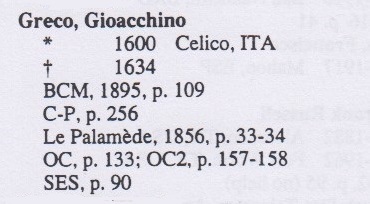
Edward Winter
From the privately circulated 1994 edition of Chess Personalia by Jeremy Gaige:

On page 117 of Historia general del ajedrez by Julio Ganzo (Madrid, 1973) a photograph of Blackburne was labelled ‘Chigorin’:
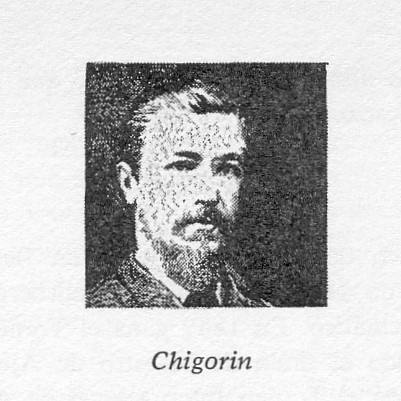
On pages 82 and 88 Ganzo’s book had pictures allegedly of Ruy López and Gioacchino Greco:
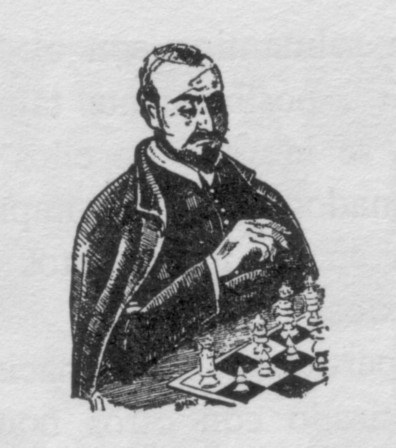
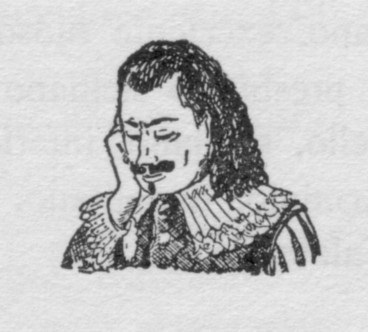
Do these illustrations have any historical basis?
(3239)
The first game in Conversational Chess (C.N. 4560) was 1 d4 f5 2 Bg5 h6 3 Bf4 g5 4 Bg3 f4 5 e3 h5 6 Bd3 Rh6 7 Qxh5+ Rxh5 8 Bg6 mate. This is a famous skirmish between Teed and Delmar which appeared in a novel figurine notation on page 44 of the June 1897 American Chess Magazine:
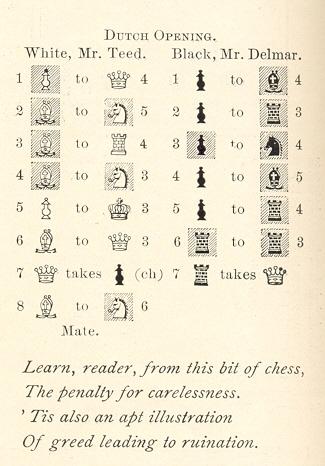
On page 244 of 200 Miniature Games of Chess (London, 1941) J. du Mont gave Teed’s victory and asserted:
‘The extreme beauty of this charming cameo loses a little of its glamour owing to the fact that the identical sequence of moves is found in one of Greco’s games (1622-1634).’
What grounds exist for that claim?
The earliest game beginning 1 d4 f5 2 Bg5 that we have found so far in a contemporary magazine is Carl Göring v Johann Berger, Graz, 1870 (Deutsche Schachzeitung, November 1870, pages 349-350). See also some later issues of the German magazine: October-November 1879, pages 298-300, May 1881, pages 153-155 and August-September 1881, page 288.
Information is sought on a game (1 d4 f5 2 Bg5 h6 3 Bh4 c5 4 e3 Qb6 5 b3 Nf6 6 dxc5 Qb4+ 7 White resigns) included in various databases and allegedly played between Hopton and Eastwood in 1860 [sic].
We conclude with a less familiar miniature, from page 411 of Brüderschaft, 10 December 1887:
P. Seufert – R.
Berlin, 2 December 1887
Dutch Defence
1 d4 f5 2 Bg5 g6 3 h4 Nh6 4 h5 Nf7 5 Qd2 h6 6 hxg6 Nxg5 7 Qxg5 hxg5 8 Rxh8 Resigns.
(4561)
Sven Mühlenhaus (Düsseldorf, Germany) writes:
‘The claim that the game originated with Greco was also made (naturally with no source provided) by Hans Carl Opfermann on pages 25-27 of his book Die Spielgeheimnisse der großen Schachkämpfer (Düsseldorf/Vienna, 1978). In his truly hilarious but simultaneously unreadable annotations Opfermann even implied that he knew what Greco and his opponent were thinking. The depth of Opfermann’s knowledge of chess history is illustrated by the fact that he systematically referred to Howard “Stounton”.’
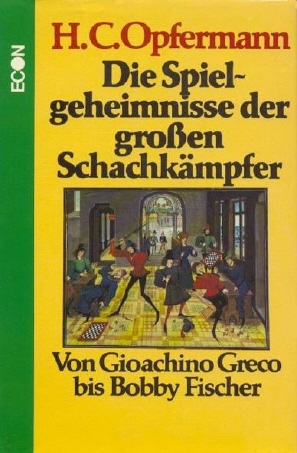
(4587)
Regarding The Knight Challenge, in C.N. 5096 Jon Crumiller (Princeton, NJ, USA) gave the following pre-nineteenth-century examples:
Mark McCullagh (Belfast, Northern Ireland) mentions that Greco’s Game of Chess is available online.
(5108)

Michael Clapham (Ipswich, England) draws attention to the above obituary notice on page 35 of the February 1920 BCM and asks for more information about Angelo Lewis.
His pseudonym was Professor Louis Hoffmann (not ‘Hoffman’ as given by the BCM and on page 186 of Betts’s Bibliography), and he produced The Games of Greco (London, 1900), as well as editions of Hoyle’s Games and books on magic and puzzles. In bibliographies he is sometimes referred to as Angelo John Lewis.
A preliminary examination of the familysearch website indicates that he was born in London on 23 July 1839, was a Master of Arts from Oxford University and a Barrister at Law, and died in 1918.
(5620)
For further information on Angelo Lewis, see C.N.s 5646 and 5716.
Gábor Gyuricza (Budapest) asks for details about a game widely given as ‘P. Damiano v T. Halász, 1512’: 1 e4 e5 2 Nf3 Nf6 3 Nxe5 Nxe4 4 Qe2 Qe7 5 Qxe4 d6 6 d4 f6 7 f4 Nd7 8 Nc3 dxe5 9 Nd5 Qd6 10 fxe5 fxe5 11 dxe5 Qc6 12 Bb5 Qc5 13 Be3 Qxb5 14 Nxc7+ and wins.
Our correspondent comments:
‘Here in Hungary no-one has ever heard of it, and Halász is a Hungarian surname (meaning “fisherman”).’
We note that the moves appeared (with no mention of Damiano or anybody named Halász) on pages 36-37 of Das Schach des Herrn Gioachino Greco Calabrois und die Schachspiel-Geheimnisse des Arabers Philipp Stamma by Moses Hirschel (Breslau, 1784) and on pages 46-48 of The Games of Greco by Professor Hoffmann (London, 1900).
(5694)
Jeremy Silman (Los Angeles, CA, USA) informs us that he has been studying the games of Gioacchino Greco (1600-circa 1634) with increasing admiration:
‘There are many games which show Greco toying with his hopelessly over-matched opponents, and one gains the impression that he was a master of tactics and of open games, and that he was so far beyond other players of his time that it was, in effect, a case of a grandmaster versus players rated between 1000 and 1800. Once in a while, Greco would face someone who could fight back, which allows us to see Greco’s positional skills. It is possible that some, or even all, of the games were fabricated, but even if they were inventions they still show a chess understanding centuries ahead of his time.
Here are two great examples (both of which will be used in my forthcoming new edition of How to Reassess Your Chess):
N.N. – Gioacchino Greco
1 e4 e6 2 d4 d5 3 e5 c5 4 c3 Nc6 5 Nf3 Bd7 6 Be3 c4 7 b3 b5 8 a4 a6 9 axb5 axb5 10 Rxa8 Qxa8 11 bxc4
(Black has to recapture the pawn on c4. Either choice is playable, but one stands out above the other.) 11…dxc4 (Breaking the old “always capture towards the center” rule. This gives Black far more to work with than the pedestrian 11...bxc4. With 11...dxc4, Black creates a home on d5 for a knight, opens up the a8-h1 diagonal for his queen (and potentially for his light-squared bishop too) and, most importantly, creates a queen’s-side majority of pawns. This means that Black, whenever he chooses to do so, can make a passed pawn by ...b4.) 12 Be2 (12 d5 exd5 13 Qxd5 Qb8 is also fine for Black.) 12…Nge7 13 O-O Nd5
(Black, with his knight on d5 and his pawn majority ready to make a passed pawn (by ...b4) any time he wants, has an excellent position.)
Source: The Games of Greco by Professor Hoffmann (London, 1900), pages 79-81.
N.N. – Gioacchino Greco
1 e4 c5 2 f4 Nc6 3 Nf3 d6 4 Bc4 Nh6 5 O-O Bg4 6 c3 e6 7 h3 Bxf3 8 Qxf3 Qd7 9 d3 O-O-O 10 f5 Ne5 11 Qe2 Nxc4 12 Bxh6 Na5 13 b4 Nc6 14 Bd2 exf5 15 exf5 f6 16 b5 Ne7 17 Qe6
(The queen has just leapt to e6, where it flexes its muscles and also dares Black to capture and give White a passed pawn on e6. But Greco sees beyond the hype and realizes that it is actually a severe weakness.) 17…Qxe6 18 fxe6 (The pawn is imposing here, but it turns out to be extremely vulnerable.) 18…Ng6 (Another way is 18...Re8 19 a4 Nd5 20 c4 Nc7.) 19 d4 d5 20 Be3 c4 21 Bc1 Re8 22 Re1 Bd6 23 a4 Nf8
(The pawn falls, leaving Black with an extra pawn and a winning position.)
Source: The Games of Greco by Professor Hoffmann (London, 1900), pages 92-93.
My impression is that Greco was further ahead of his contemporaries than any player who came after him. He was clearly of grandmaster strength at tactics, his openings were (for his time) cutting-edge, and his play in open positions was world-class. Yes, he took liberties which would not stand up against stronger opponents, but I think that he was well aware of his opponents’ failings and thus had little or nothing to worry about – he swung the bat freely in an effort to create classic mates and attacks that no doubt amused him.
He had solid positional skills too. In the first game above, his capture away from the center (11...dxc4) was very astute, and in the second game he was more than happy to play for the win of a pawn (although, even then, he ended up with a strong king’s-side attack).
Moving forward, I feel that Philidor may have been the best of his time, but other players were close (and Greco would have slaughtered everyone of Philidor’s day, including Philidor). Labourdonnais was extremely strong, but that was 200 years after Greco’s reign. Even so, in my opinion Greco would have given both Labourdonnais and Morphy a stern challenge. In the modern age (starting with Steinitz), Greco would have needed to pick up many new tricks to compete, but I think that talent like his would have blossomed in any period.
Greco was a man in an age of chess children. There never was, and never will be again, a player so far ahead of his time.’
(6320)
Han Bükülmez (Ecublens, Switzerland) asks about a line in Damiano’s Defence which was discussed in Gary Lane’s Opening Lanes article of 2 March 2011 [Chess Café link no longer working]: 1 e4 e5 2 Nf3 f6 3 Nxe5 fxe5 4 Qh5+ Ke7 5 Qxe5+ Kf7 6 Bc4+ d5 7 Bxd5+ Kg6 8 h4 h5
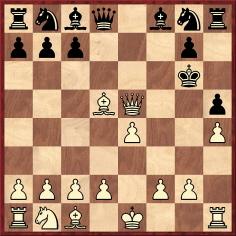
At this point Lane wrote:
‘9 Bxb7! This is the move that has sealed the fate of the Damiano Defence. White wins material and still has a terrific attack in reserve. I came up with this move some time ago thanks to the help of the computer and no doubt others have also discovered it, but as far as I know nobody has had the chance to play it at the board.’
We would simply point out that 9 Bxb7 goes back to Gioacchino Greco. See, for instance, page 72 of The Games of Greco by Professor Hoffmann (London, 1900):
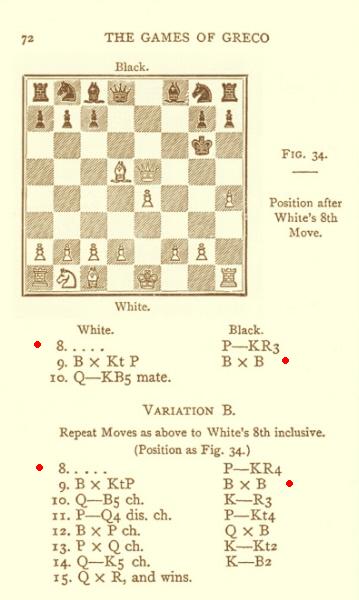
(7011)
Our item below appeared on pages 21-22 of the Autumn 1996 Kingpin:
When was the Bxh7+/Ng5+ attack first played? In The Chess Companion Irving Chernev annotated the game Morphy v Guibert, Paris, 1858. After Black’s 7...h6, he wrote (page 186):
‘Anybody else would have castled and fallen into the trap 8 BxPch KxB 9 N-N5ch, etc. An old trap to you and me, but it was invented 25 years after this game was played!’
Chernev contradicted himself two pages later on (an item reprinted from his column in the July 1953 Chess Review):
‘Another little idea that Paulsen anticipated is the ritual sacrifice of BxPch in the French Defense. Credit is usually given to Fritz, who surprised Mason with it in the Nuremberg tournament of 1883. So here to dispute the claim is an entry from a match [Paulsen v Schwarz] played in 1879.’
But what about Greco’s use of Bxh7+/Ng5+ in the early seventeenth century? An example even appears on page 90 of a previous book by Chernev, 1000 Best Short Games of Chess.
Page 331 of Kings, Commoners and Knaves mentioned that in 1925 the second issue of Les Cahiers de L’Echiquier Français (page 59) suggested that the Fritz v Mason game was the earliest specimen of Bxh7+ in a tournament game.
Chernev’s article about the Morphy game had originally appeared on the inside front cover of the April 1950 Chess Review:
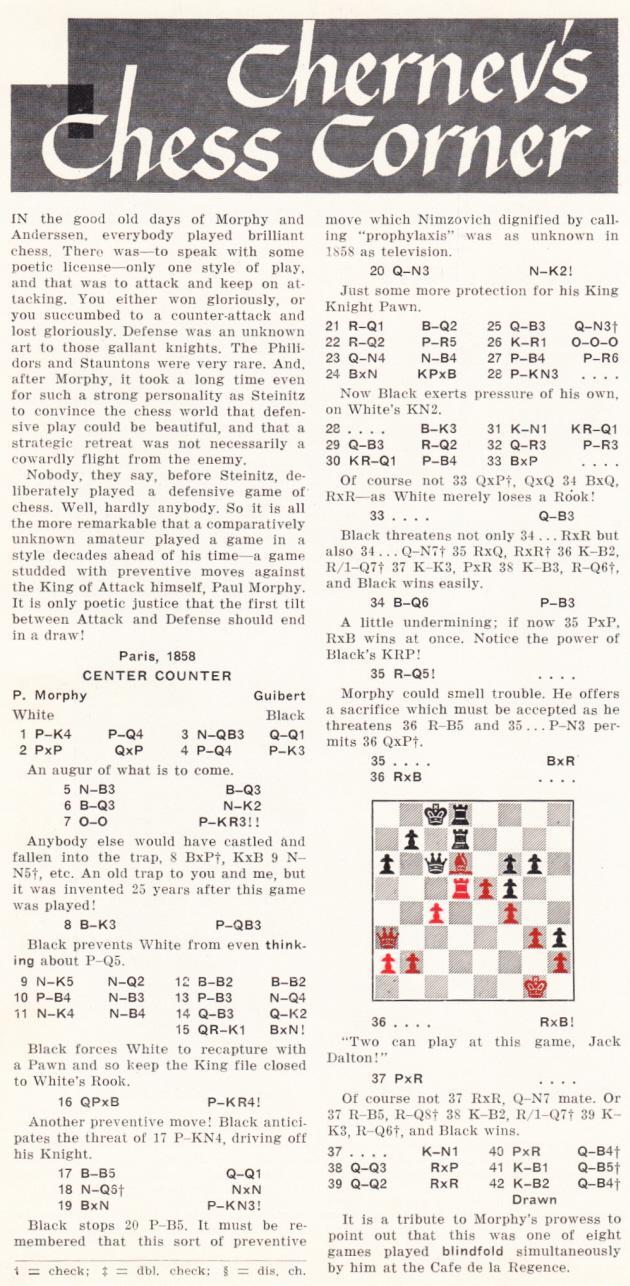
Is any biographical information available about Guibert?
(7979)
Some information about Guibert was given by Rod Edwards (Victoria, BC, Canada) in C.N. 7982.
Page 5 of Tony Kosten’s 1995 Batsford book on 1 e4 e5 2 Nf3 f5, [The] Latvian Gambit (the definite article is on the cover but not on the title page), stated that the opening ‘was renamed the Latvian Gambit at the 1937 FIDE Congress’.
The start of an article on the opening published earlier that year, on pages 74-75 of the Chess Review, April 1937:
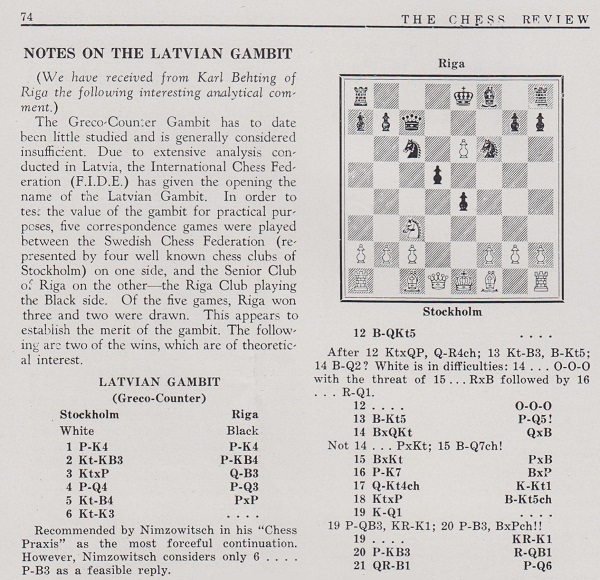
The name ‘Latvian Gambit’ had been officially adopted by FIDE several years earlier, in its publication discussed in C.N. 3902 and 10058, Débuts du jeu d’échecs (Prague, 1934). From page 35:

From page 81 of the sixth edition of Modern Chess Openings (Philadelphia, 1939):
‘... Greco’s Counter-Gambit has been given a new lease of life by the researches of Latvian analysts (particularly K. Behting), who maintain that the gambit is perfectly sound. Their analysis seems to be quite correct, but in practical play by Black usually loses.’
The earliest edition of Modern Chess Openings to include the specific term ‘Latvian Gambit’ was the seventh (London, 1946). From page 102:
‘The Greco Counter (now called Latvian) Gambit.’
Even so, in English-language sources the names remained more or less interchangeable. For instance, the May 1968 CHESS (pages 244-251) and the end-May 1968 issue (pages 281-284) had an ‘amazing article’ on 1 e4 e5 2 Nf3 f5 by B. Simm (‘Simms’ in the heading to the first part). The two parts were entitled, respectively, ‘The Latvian Gambit (alias Greco Counter-Gambit)’ and ‘The Latvian or Greco Counter-Gambit’.
To what extent modern theoreticians give due attention to old analysis is an uncomfortable question. To mention a couple of sources at random, there was a large amount of material, mainly by Stasch Mlotkowski, on the ‘Greco Counter-Gambit’ in the BCM in 1915-16, and a two-part article entitled ‘Zum Lettischen Gambit’ by Walter Henneberger was published in the Schweizerische Schachzeitung, January 1941, pages 6-9, and February 1941, pages 21-23.
(10123)
The opening was also discussed in C.N. 10122.
Luc Winants (Boirs, Belgium) draws attention to this position (White mates in three) ...
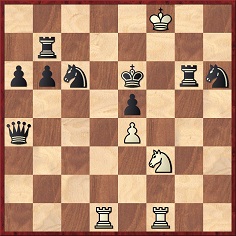
... on pages 337-339 of Le jeu des Eschets by Gioacchino Greco (Paris, 1669):
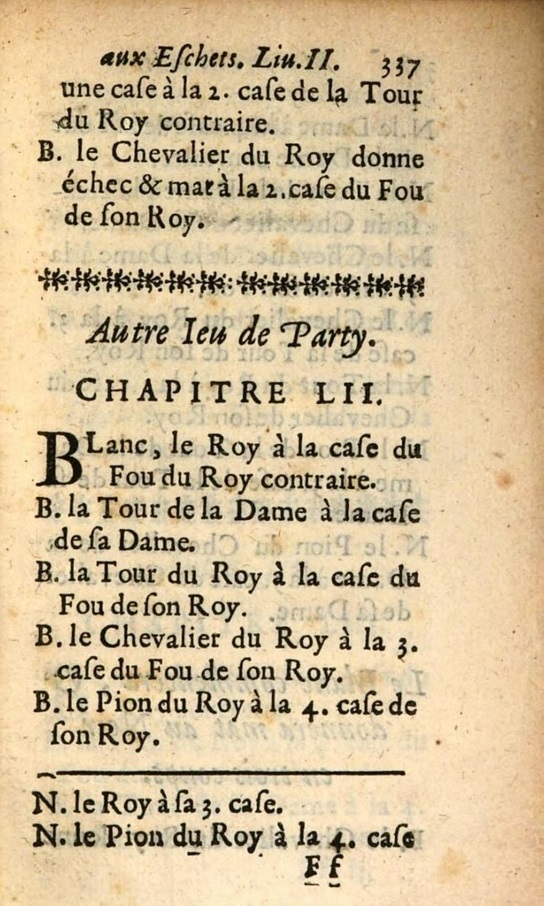
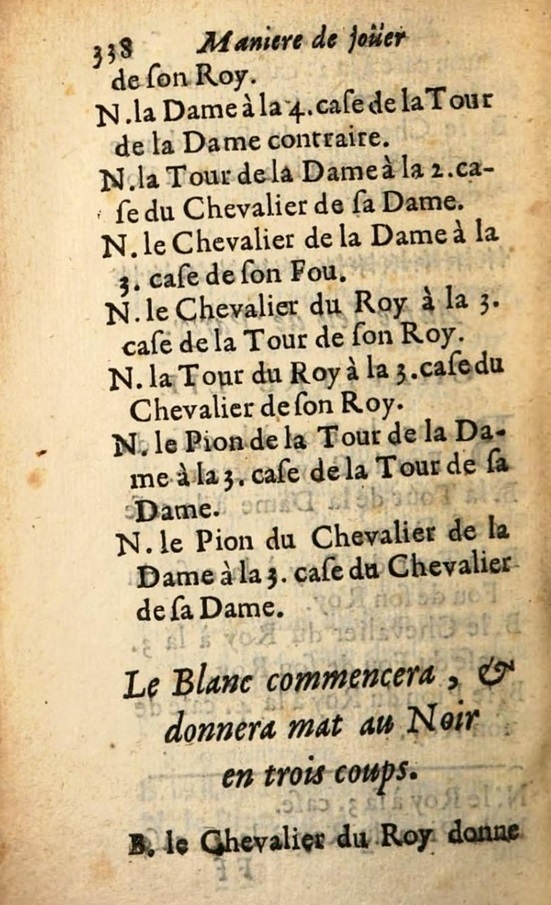
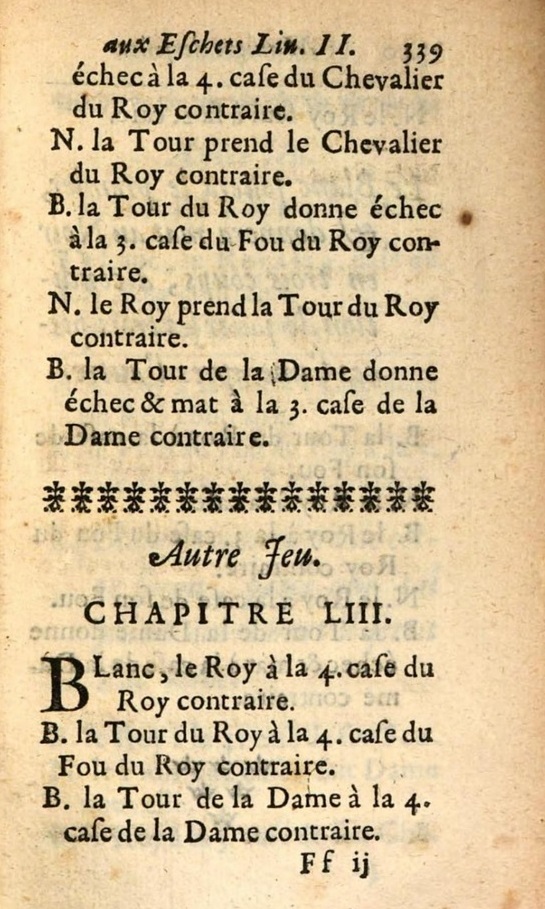
(11512)
Regarding other Greco games, see Queen Sacrifices.
To the Archives
for other feature articles.
Copyright Edward Winter. All rights reserved.